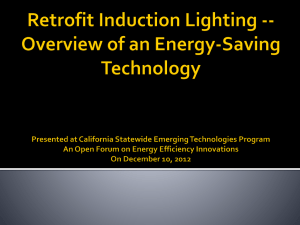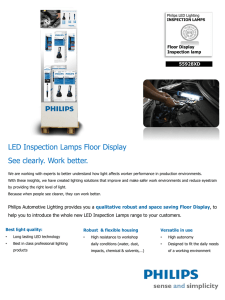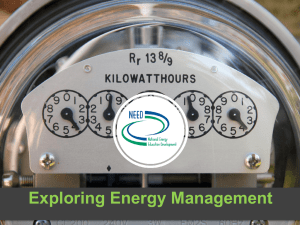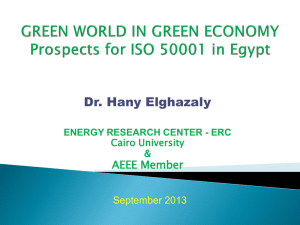lighting
advertisement
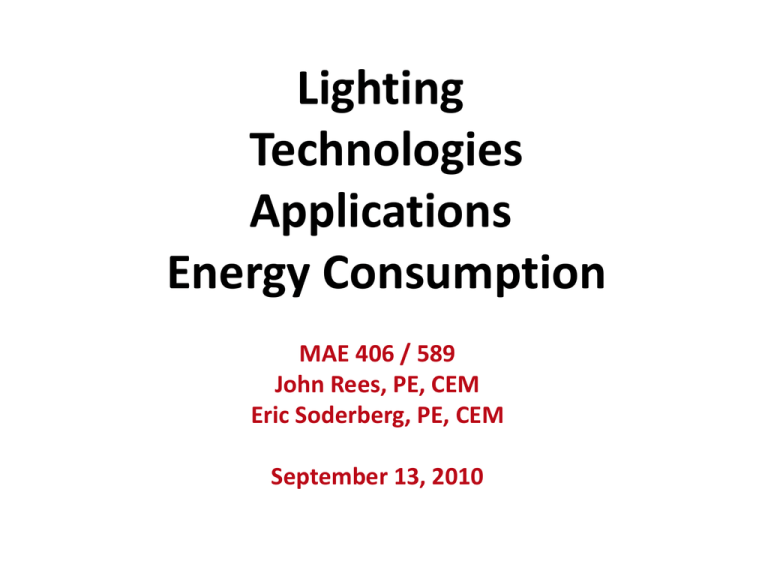
Lighting Technologies Applications Energy Consumption MAE 406 / 589 John Rees, PE, CEM Eric Soderberg, PE, CEM September 13, 2010 LIGHTING FUNDAMENTALS The 3 Pillars of Energy Efficient Lighting Visual Visual Task Task WATTS LUMENS FOOTCANDLES Meet target light levels Efficiently produce and deliver light Automatically control lighting operation Most Important Slide in Today’s Seminar! 3 Lighting Fundamentals - Illumination • Light Output. – Measured at the lamp surface. – Measured in lumens. • Illuminance or Light Level. – Measured at the working surface. – Measured in foot-candles. • Luminance or Brightness. – Measured at an angle to the working surface. – Measured in footlamberts. Targeted Illumination Levels • Targeted illumination level is determined by: – Tasks being performed (detail, contrast, size). – Ages of the occupants. – Importance of speed and accuracy. Recommended Illumination Levels Activity Illumination Footcandles Offices: Average Reading and Writing Offices: Hallways 50-75 10-20 Offices: Rooms with Computers Auditoriums / Assembly Places Hospitals: General Areas 20-50 15-30 10-15 Labs / Treatment areas 50-100 Libraries Schools 30-100 30-150 Quality of Illumination • Quality of illumination may affect worker productivity. • Quality is affected by: – Glare. Too bright. – Uniformity of illumination. – Color rendition. Ability to see colors properly. • Scale is 0 to 100 (100 is best) – Color Temperature. Warm to Cool. • Measured in degrees kelvin. 3000 is warm (yellowish); 5000 is cool or “daylight”. Color Rendering Index (CRI) A relative scale indicating how perceived colors illuminated by the light source match actual colors. The higher the number the less color distortion from the reference source. 85 -100 CRI = Excellent color rendition 75 - 85 CRI = Very Good color rendition 65 - 75 CRI = Good color rendition 55 - 65 CRI = Fair color rendition 0 – 55 CRI = Poor color rendition Color Temperature (K˚) A measure of the “warmth” or “coolness” of a light source. ≤ 3200K = “warm” or red side of spectrum ≥ 4000K = “cool” or blue side of spectrum 3500K = “neutral” 5000K = “Daylight” North Sky - 8500K Color Temperature Scale Daylight Fluo - 6500K Cool White - 4100K Halogen – 3100K Warm White - 3000K Incandescent – 2700K HPS - 2100K 10 Color Rendition cool source is used warm light source is neutral light source is enhancing blues and used, enhancing reds used greens and oranges Color rendering, expressed as a rating on the Color Rendering Index (CRI), from 0-100, describes how a light source makes the color of an object appear to human eyes and how well subtle variations in color shades are revealed. The higher the CRI rating, the better its color rendering ability. Efficiency • Lighting efficiency is expressed as lumens output/wattage input. – Ranges from 4 to 150 lumens/watt. • Show overhead. Lamp Lumen Depreciation • As lamps age, they lose a certain amount of output. • Old T12 fluoresecents can lose up to 30% of output over their life. • New T8 fluorescents maintain up to 95% of original lumens. • This depreciation must be accounted for when installing new lighting system. LIGHTING TYPES Luminaires • Luminaire = Lighting fixture – Lamps – Lamp sockets – Ballasts – Reflective material – Lenses, refractors, louvers – Housing • Directs the light using reflecting and shielding surfaces. Luminaires (cont’d) • Luminaire Efficiency – Percentage of lamp lumens produced that actually exits the fixture. – Types of luminaires • Direct (general illumination). • Indirect (light reflected off the ceiling/walls; “wall washers”). • Spot/Accent lighting. • Task Lighting. • Outdoor/Flood Lights. Types of Lighting • • • • • Incandescents/Halogens. Fluorescents. High Intensity Discharge (HID). Inductive. Light Emitting Diode. Incandescent Lamps • One of the oldest electric lighting technologies. • Light is produced by passing a current through a tungsten filament. • Least efficient – (4 to 24 lumens/watt). • Lamp life ~ 1,000 hours. Incandescent Lamps (cont’d) • High CRI (100) – Warm Color (2700K) • Halogen 2900K to 3200K) • Inexpensive • Excellent beam control • Easily dimmed – no ballast needed • Immediate off and on • No temperature concerns – can be used outdoors • 100, 75, 60 and 40 watt lamps will be going away per 2007 law beginning 2012 Tugnsten-Halogen Lamps • A type of incandescent lamp. • Encloses the tungsten filament in a quartz capsule filled with halogen gas. • Halogen gas combines with the vaporized tungsten and redeposits it on the filament. • More efficient. • Lasts longer (up to 6,000 hrs.) Fluorescent Lamps • Most common commercial lighting technology. • High Efficicacy: up to 100 lumens/watt. • Improvements made in the last 15 years. – T12: 1.5 inch in diameter. – T8: 1 inch in diameter. • ~30% more efficient than T12. – T5: 5/8 inch in diameter. • ~40% more efficient than T12. Fluorescent Lamps (cont’d) • Configurations – Linear (8 ft., 4 ft., 2 ft., 1 ft.) – Ubend (fit in a 2 ft. x 2 ft. fixture). – Circular (rare, obsolete). – Fixtures can be 4, 3, 2, or 1 lamp per fixture. • Output Categories – Standard Output (430 mA). – High Output (800 mA). – Very High Output (1,500 mA). Schematic of Fluorescent Lamp Phosphor crystals Mercury atom Electron Electrode Compact Fluorescent Lamps (CFLs) • Fluorescent lamp that is small in size (~2 in. diameter, 3 to 5 in. in length). • Developed as replacement for incandescent lamps. • Two Main Types – Ballast-integrated. – Ballast non-integrated (allows only lamp to be replaced). Compact Fluorescent •Excellent color available – comparable to incandescent •Many choices (sizes, shapes, wattages, output, etc.) •Wide Range of CRI and Color Temperatures •Energy Efficient (3.5 to 4 times incandescent) •Long Life (generally 10,000 hours – lasts 12 times longer than standard 750 hour incandescent lamps) •Less expensive dimming now available (0-10v dimming to 5%) •Available for outdoor use with amalgam technology Compact Fluorescent Lamps (cont’d) • Use ¼ the power of an incandescent for an equivalent amount of light. (an 18-watt CFL is equivalent to a 75-watt incandescent.) • 10,000 hour life. (10x an incandescent). • Saves about $30 over the life of the CFL. Ballasts • Auxiliary component that performs 3 functions: – Provides higher starting voltage. – Provides operating voltage. – Limits operating current. • Old type ballasts were electromagnetic. • New ballasts are electronic. – Lighter, less noisy, no lamp flicker, dimming capability). Ballast Factor •DEFINITION: The fraction of rated lamp lumens produced by a specific lampballast combination •APPLICATIONS: High Ballast Factor (1.00-1.30) Increases output AND energy consumption Typical Ballast Factor (0.85-0.95) Comparable light output in one-to-one replacement Low Ballast Factor (0.47-0.83) Decreases light output AND energy consumption •For optimal efficiency lamps and ballasts must be properly matched. •Maximize energy savings by selecting electronic ballasts with ballast factor that provides target illuminance. Ballast Circuit Types • Instant Start Ballast – starts lamp instantly with higher starting voltage. Efficient but may shorten lamp life. • Rapid Start – delay of about 0.5 seconds to start; supplies starting current to heat the filament prior to starting and continues during operation. Uses 2 to 4 watts more than an instant start ballast. • Programmed Rapid Start - delay of about 0.5 seconds to start; starting current heats the filament prior to starting, then cuts off during operation. High Intensity Discharge (HID) Lamps High Intensity Discharge Fixtures High Intensity Discharge (HID) Lamps • produces light by means of an electric arc between tungsten electrodes housed inside a translucent or transparent fused quartz or fused alumina (ceramic) arc tube filled with special gases. High Intensity Discharge Lamps (cont’d) • Arc tube can be filled by various types of gases and metal salts. • HID lamps are used in industrial high bay applications, gymnasiums, outdoor lighting, parking decks, street lights. • Efficient (up to 150 lumens/watt). • Long Life (up to 25,000 hours). • Drawback – take up to 15 minutes to come up to full light after power outage. High Intensity Discharge Lamps (cont’d) • Types of HIDs – Mercury Vapor (obsolete) – Sodium Vapor • High pressure • Low pressure – Metal Halide • Arc tube contains argon, mercury, and metal halides. • Gives better color temperature and CRI. Metal Halide Lamps • Most common HID in use today. • Recent Improvements. – Allow higher pressure & temperature. – Better efficiency, better CRI and better lumen maintenance. – Pulse Start vs. older Probe Start – Ceramic vs. older Quartz arc tube. Light Emitting Diodes (LED) • Latest Lighting Technology. • Invented in 1962. • In the past, used as indicator lights, automotive lights, and traffic lights; now being introduced for indoor and outdoor lighting. • LED is a semiconductor technology. • Electroluminescence. Electrons recombine with holes in the semiconductor, releasing photons. Light Emitting Diodes (cont’d) • Lower energy consumption. • Longer lifetime (50,000 to 100,000 hrs). • Smaller size. • Faster switching. • Greater durability and reliability. • Cycling. • Dimming. LED Replacement Lamps for a 4-ft. Fluorescent Fxture Comparison of LED with a Fluorescent Lamp Watt Rating, typical B.F. = 0.8 Lumens, initial CRI Color Temperature Life Expectancy 12 hrs per start / 3 hrs per start Light output at 0° C EverLED-TR Popular T8 Brand Fluorescent 22W 34W Equivalent 2850 85 85 5000K 5000K 10 years 10 years 20000 hours 16000 hours 20% increase 50% decrease LED Applications Successfully used today for many markets • Signs & Traffic signals (most common) • Displays (change colors for attention) • Exit Signs (most common) • Indicators and Flashlights • Under Counter & Coves • Accent • Parking Garage & Outdoor • Downlights • Food Freezers LED vs. HPS 41 Comparison: LED to Ceramic Metal Halide Cree LED Lighting LRP38 – Total Wattage = 36W Ceramic Metal Halide – Total Wattage ~ 158 to 237W 42 Induction Lights • Light source in which the power required to generate light is transferred from the outside of the lamp envelope by means of electromagnetic fields. • Type of fluorescent lamp – uses radio waves rather than arc to excite phosphor coating on lamp to glow • Long lifespan due to the lack of electrodes - between 65,000 and 100,000 hours depending on the lamp model; • High energy conversion efficiency of between 62 and 90 Lumens/Watt [higher wattage lamps are more energy efficient]; • High power factor due to the low loss of the high frequency electronic ballasts which are typically between 95% and 98% efficient; • Minimal Lumen depreciation (declining light output with age) compared to other lamp types as filament evaporation and depletion is absent; • “Instant-on” and hot re-strike, unlike most conventional lamps used in commercial/industrial lighting applications (such as Mercury-Vapor lamp, Sodium Vapor Lamp and Metal Halide Lamp); • Environmentally friendly as induction lamps use less energy, and use less mercury per hour of operation than conventional lighting due to their long lifespan. Induction Lighting Type of fluorescent lamp – uses radio waves rather than arc to excite phosphor coating on lamp to glow Advantages: • QL and Icetron: 60,000 to 100,000 hours – if used 12 hours each day will last 20 years! • Good for hard to maintain locations Disadvantages: • Large light source – difficult to control beam of light making it inefficient for delivered and task lumens • Expensive - $200+ adder to HID • No industry standards for Induction Induction Applications • Applications where maintenance is expensive and/or difficult • 24 hour a day.7 days a week applications • Bridges • Low Bay Industrial • Select Outdoor Lighting Applications • Long burning hour applications Exit Signs • Old incandescent exit signs used (2) 20-watt incandescent lamps. – At $0.08/kWh, energy cost for 1 sign = $28/yr. • CFL exit signs use 10 to 12 watts – Energy cost for 1 sign = $7 to $8.50/yr. • LED exit signs use 3 to 4 watts – energy cost for 1 sign = $3 to $4/yr. • Photoluminescent sign uses 0 watts, but may have (slightly) radioactive material. – New technology claims completely non-toxic and recyclable. Outdoor Lighting • Older technology for outdoor lighting – High pressure sodium – Metal Halide • Newer technology – Compact fluorescents – LEDs • Solar street lights (economical when electric lines don’t need to be run in a new installation). ENVIRONMENTAL CONSIDERATIONS Hazardous Waste Disposal Hazardous Waste Lamps will now be regulated under the Federal Universal Waste Rule which was first developed to regulate the disposal of other widely generated wastes that contain toxic materials, such as batteries and pesticides State Rule supersedes Federal Rule Under current federal law, mercury-containing lamps (fluorescent, HID) may be hazardous waste The rule applies only to lamps that fail the TCLP (Toxicity Characteristic Leaching Procedure) test which is used to determine if a waste is hazardous. Mercury Content of Lamps TYPICAL MERCURY CONTENT OF VARIOUS LAMPS 250 watt Metal Halide lamp 250 watt High Pressure Sodium lamp Pre 1988 T12 Fluorescent Post 1988 T12 Fluorescent 12 mg Typical T8 Fluorescent Tube Typical Compact Fluorescent (CFL) 38 mg 15 mg 45 mg 4-5 mg 4-5 mg 4-5 mg is less mercury than a coal fired power plant will emit while producing the additional energy to power an equivalent incandescent lamp. Lamps containing mercury that fail the TCLP test must be recycled! EPA encourages responsible disposal practices to limit the release of mercury into the environment. EPA encourages lamp recycling LIGHTING ECONOMICS $$ • Simple Payback • Return on Investment (ROI) • Internal Rate of Return (IRR) • Net Present Value (NPV) LIGHTING ECONOMICS $$ Simple Payback Return on Investment (ROI) Internal Rate of Return (IRR) Net Present Value (NPV) Simple Payback Examples Simple Payback Simple Payback is the number of years it takes an energy saving measure to repay the initial investment for the new system. It does not account for the time value of money and it also does not consider the savings that occur after the payback point. Most private companies require a simple payback of 2 years or less. For energy saving measures, they will sometimes accept a 3 to 5 year payback. Government agencies can accept longer paybacks than private companies. SIMPLE PAYBACK = TOTAL PROJECT COST / ANNUAL SAVINGS Return on Investment - ROI ROI is the inverse of Simple Payback and has all of the qualifiers of a simple payback. It does not account for the time value of money and also it does not consider the savings that occur after the payback point. It is sometimes called Rate of Return. ROI is expressed as a percentage. It is often compared to other investment yields. Internal Rate of Return (IRR %) IRR is a hurdle rate. The IRR is the discount rate of return at which a project’s NPV=0. IRR accounts for life-cycle cash flows and time-value of money, but the percentages alone should not be compared for ranking (choosing one alternative over another) still use the NPV results as well. IRR is the discount rate that delivers a net present value of zero for a series of future cash flows. IRR is expressed as an interest yield. Any interest yield equal to or less than the IRR for a project is a “yes” decision (i.e. the IRR is greater than the cost of capital). Net Present Value ($) •NPV adjusts for the time value of money by discounting incremental future cash flows to the present time using a discount rate appropriate to those cash flows. NPV ($) is a profitability measure and can be used to rank one lighting alternative over another. The higher the $ profit NPV, the better the alternative. The NPV, to be appropriately used, should be calculated by applying the after tax cost of capital to the after tax cash flows. Example: Simple Payback & ROI A lighting upgrade is estimated to save $5,000 a year and cost $25,000. What are the simple payback and return on investment (ROI)? Simple payback ROI = Cost / Annual Savings = $25,000 / $5,000 = 5 years = 1 / Simple Payback = 1/5 = 20% Example: Energy & Cost Savings Existing lighting in the Method Road Greenhouse consists of 10 fixtures containing ten 4’, 4 lamp T12 fixtures that consume 154 watts of electrical power. At $0.09/kWh, what is the annual cost of operating these fixtures 2,000 hours a year? 10 x 154 watts x 2,000 hours/1,000 = 3,080 kWh 3,080 x $0.09 = $2,772 per year These fixtures are replaced by fixtures containing 25 watt T8 lamps with low BF ballasts which only consume 89 watts per fixture. What is the annual cost of operation? 10 x 89 watts x 2,000 hours/1,000 = 1,780 kWh 1,780 x $0.09 = $1,602 per year Cost savings = $1,170 per year Other Benefits from Energy Efficient Lighting Retrofit • Improved Color Rendition/Visibility in Space • Longer Lamp Life •Less Maintenance (Normally a result of longer lamp life) • Adjust to target light levels (IES) • Improved Controls • HVAC Savings – Typically 5% above lighting savings for cooled spaces • Tax Incentives – Generally tax deductions • Incentive from Utility Rebates – Both Progress & Duke have programs HVAC Savings from a Lighting Retrofit •1 watt saved = 3,412 BTUs of heat removed •Heat removed with Efficient Lighting is: • A savings when cooling (A/C is on) • A cost when heating is on •Rules of Thumb to count HVAC savings • Unitary Equipment: Lighting Savings x .1 to .2 • Chiller Equipment: Lighting Savings x .05 to .1 •Example: Lighting Savings = $2,000.00 $2,000 x .1 = $200 savings from Unitary HVAC Change from Old to New and Save Energy and $$ OLD TECHNOLOGY => NEW TECHNOLOGY • T12 Fluorescent – 4’ and 8’ Systems • T8, T5 and T5HO Fluorescent Systems • Magnetic Ballasts • Electronic Ballasts • Incandescent • Halogen IR, MH & LED • Halogen • Metal Halide and LED • Probe Start Metal Halide and Mercury Vapor • Pulse Start and Ceramic Metal Halide • Neon •LED • Manual Controls •Automatic Controls, Bi-Level and Continuous Dimming Systems Ballast Factor •DEFINITION: The fraction of rated lamp lumens produced by a specific lampballast combination •APPLICATIONS: High Ballast Factor (1.00-1.30) Increases output AND energy consumption Typical Ballast Factor (0.85-0.95) Comparable light output in one-to-one replacement Low Ballast Factor (0.47-0.83) Decreases light output AND energy consumption •Maximize energy savings by selecting electronic ballasts with ballast factor that provides target illuminance. Energy Savings Potential With Occupancy Sensors Application Energy Savings Offices (Private) 25-50% Offices (Open Spaces) 20-25% Rest Rooms 30-75% Corridors 30-40% Storage Areas 45-65% Meeting Rooms 45-65% Conference Rooms 45-65% Warehouses 50-75% Source: CEC/DOE/EPRI Savings can be determined with data logger installed in room or area for 1 to 2 weeks Types of Lighting Controls – Occupancy Sensors – Bi-level Switching – Time Clock – Photo Sensors – Lighting Control Systems Occupancy Sensors •Automatically turn lights off when spaces are unoccupied •Adjustments for sensitivity and time delay •Proper selection, location, and adjustment of sensors is key to reliable operation •Ask manufacturer about load limits and compatibility with electronic ballasts •Some are low voltage sensors and use a power pack that acts as 1) a switch and 2) a transformer (120V to 240V) Passive Infrared Sensors (PIR) •Detect movement of heat-radiating sources between radial detection zones •Line-of-sight is required (30’ max) •Larger motion is required to trigger sensor at greater distance •Most sensitive to motion lateral to sensor •Coverage pattern can be modified to minimize false triggers Ultrasonic Sensors •Detect movement by sensing disturbance in reflected ultrasonic frequency pattern •Line-of-sight is not required if hard surfaces exist in enclosed space •Most sensitive to motion toward/away from sensor •Sensitive to air movement vibration Ultrasonic Wall Sensor • Automatic Control • Use in areas where there are • large periods of unoccupied time • Excellent for bi-level control to • maximize energy savings • Does not require direct line of sight • Adjust sensitivity and time delay • for best results Dual-Technology Sensors •Greater reliability from using both infrared (IR) and ultrasonic (US) sensing technologies •Typical operation settings: •IR and US signals for lights to turn on •IR or US signals for lights to stay on •Absence of IR and US signals for lights to turn off Energy Efficiency and Cost Savings • Lighting electrical savings are possible while improving lighting comfort! Benefits from Energy Efficient Lighting Retrofit • • • • Improved Color Rendition/Visibility in Space • Improved Controls • HVAC Savings • Tax Incentives • Incentive from Utility Rebate Programs Less Maintenance Adjust to target light levels (IES) Longer Lamp Life HID Upgrade to Fluorescent Lamps • 400-Watt Metal Halide = 455 watts input • 6-Lamp T8 Fixture = 234 watts Older Lighting Technology Subject to be Changed Out •T-12 Fluorescent-4’ and 8’ Systems •Fluorescent Magnetic Ballasts •Incandescent •Standard Metal Halide •Mercury Vapor •Neon •Manual Controls New Energy Efficient Lighting Replacements •T8, T5 and T5HO Fluorescent Systems •Electronic Ballasts •Halogen •Pulse Start and Ceramic Metal Halide •LED •Bi-Level and Continuous Dimming Systems •New Fixtures Change from Old to New and Save Energy and $$ OLD TECHNOLOGY => NEW TECHNOLOGY • T12 Fluorescent – 4’ and 8’ Systems • T8, T5 and T5HO Fluorescent Systems • Magnetic Ballasts • Electronic Ballasts • Incandescent • Halogen IR, MH & LED • Halogen • Metal Halide and LED • Probe Start Metal Halide and Mercury Vapor • Pulse Start and Ceramic Metal Halide • Neon •LED • Manual Controls •Automatic Controls, Bi-Level and Continuous Dimming Systems Fluorescent Change-out •Existing: 4-lamp 2’x4’ Fixture with F34T12CWES lamps and EE magnetic ballasts – lowest efficiency allowed by code today. •Replacement: 4-lamp 2’x4’ Fixture with F32T8/835 lamps and electronic ballasts BF=0.88 (standard BF) •What is wrong with this energy efficient change-out? We did not use correct new technology to Maximize Energy Savings and meet target light levels! •Best options for replacing 34-watt T12 fluorescent systems: •Low Power electronic ballasts (BF=0.78) •Energy saving 4’ lamps (30,28, or 25w) •Less lamps per fixture (3 instead of 4) •Minimal additional cost and can Lock-in maximum energy savings with low power ballasts and fewer lamps per fixture •Use with Extra Performance or Energy Savings lamps ad correct ballast factor to meet target light levels and maximize energy savings! “Super T8” Fluorescent System •Older T8s called “700 series” •Newer Super T8s called “800 series” •3000K, 3500K, or 4100K versions •30,000 hour lamp life @ 3 hours per start •3100-3150 initial lumens •Universal Voltage (120-277V) •4-foot lamp: 30, 28 or 25 watts; Low input wattage (4-lamp: 93/89 watts) •95% lumen maintenance @ 8000 hours •Low Temperature Starting (0˚F) •Lamp/Ballast System Warranty 5 Years •85 CRI •Program Start Ballasts •TCLP-compliant Instant Start Super T8 vs. Standard T8 • 800-series Super T8s have 96% of system lumens of 700-series lamps with standard ballasts •19% reduction in power •Double lamp life (3 hrs. per start) •Maximum life on occupancy sensors 25 Watt T8 Advantage Long Life Lamp from Philips Lighting •Long lamp life (40,000 hours of rated average life at 12 hours per start on Optanium™ Instant Start ballasts and 46,000 hours of rated average life at 12 hours per start on Optanium™ Programmed Start Ballasts) •2400 lumens with 95 percent lumen maintenance •Superior color rendering (a CRI of 85) •Low mercury (Philips ALTO® lamps average 70% less mercury than the 2001 industry average for fluorescent lamps up to 60 inches, which are not TCLP compliant) 1.7 mg Mercury per 4’ lamp Fluorescent Lamp/Ballast Change-out vs. New Fixture “Rules of Thumb” •Install new fixtures when: •Existing fixtures are over 20 years old •Lamp holders are worn out •Multiple components are failing •Design requires change in fixture type •Retrofit existing fixtures with lamps & ballasts when: •Existing fixtures are less than 20 years old •Lamp holders and other components are still good •Budget is very tight •Expensive/Difficult/Environmental Conditions Present (i.e. asbestos or excessive piping and ducts in ceiling, etc.) T5 and T5HO Systems •One T5HO lamp provides similar maintained lumen output to two T8 lamps (4750 vs. 4669 maintained lumens) •Maintained lumens are higher – fixtures are smaller •Peak light output at 95˚F ambient air temperature instead of 77˚F with T8 and T12 •Amalgam technology has been added to provide a more constant lumen output across a broad range of ambient temperatures! T5 and T5HO Systems •Disadvantages • T5 and T5HO lamp life is less than T8s • The bulb wall surface of the T5 is very bright. Care must be exercised in using T5 lamp in direct lighting applications. • Costs higher than T8 – cost can be balanced by a reduction in the number of luminaries used. • Lead times may be longer – T5s require compete fixture replacement. • In cooler temperatures or high CFM air distribution the T5 or T5HO may not perform well (peak light output at 95 °F). • May not work well with occupancy sensors due to slow lumen run-up with cold start. T5HO vs. T8 Application Rules of Thumb •≤ 20’ – use T8 •≥ 20’ – use T5HO •18’ to 25’ – either T8 or T5HO can be used successfully •Over 50 types of 4’ T8 lamps available •Two T5 lamps: 28w T5 and 54w T5HO •To get T5HO performance out of T8 lamps, use high-lumen/high performance T8 lamps •Typical T8 electronic ballast factors range from 0.72 to 1.2. T5HO vs. T8 for Warehouse Aisles Rule of Thumb •In general for warehouse aisles, T5HO will perform better in non-airconditioned spaces and T8 performs better in air-conditioned spaces. •Reason: Ambient temperature of T5HO rating for peak performance is 35 degrees C (95F) and T8 is rated at 25C (77F). Source: Warehouse aisle lighting – p. 16 – LD&A Feb 2009article by Siva K. Haran, PE, LEED, AP, IES HVAC Savings from Lighting Retrofit •1 watt saved = 3,412 BTUs of heat removed •Heat removed with Efficient Lighting is: •A savings when cooling (A/C is on) •A cost when heating is on •Rules of Thumb to count HVAC savings •Unitary Equipment: Lighting Savings x .1 to .2 •Chiller Equipment: Lighting Savings x .05 to .1 •Example: Lighting Savings = $2,000.00 $2,000 x .1 = $200 savings from Unitary HVAC An Increase in Quality Can Improve Worker Productivity • 1% increase in productivity is about equal to one sick day • Improve employee satisfaction and reduce turnover/replacement expenses for new employees. • Improves Company bottom line • Indirect Lighting is preferred by many today! What’s the Most Efficient Light Source? Daylighting Advantages Excellent light source for almost all interior spaces – offices, homes, retail, schools and more; People prefer it! Field research indicates that with daylighting: • Learning is enhanced • Retail sales increase (Wal-Mart study) • Employee satisfaction increases Energy Savings is realized when controls are used Conducting a Lighting Survey Why Conduct a Lighting Survey? – to identify improvement opportunities. It is a systematic exam and appraisal of building lighting systems. Step 1 – Establish a base line of performance Step 2 – Identify opportunities for improvement Step 3 – Calculate savings and potential payback The quality of the information collected in the survey has a direct impact on steps 2 and 3 Suggestions for a Lighting Survey •Ask the right questions to meet the client’s goals •Gather ALL the right information •Don’t assume – check the existing equipment to obtain accurate information •Determine Economic Calculations Required •Is a test installation needed? •Lighting Fixtures •Controls •Consider all drivers to reduce the payback •Use a pre-printed form or spreadsheet template Information and Data to Collect in a Lighting Survey • Floor plan of the building/space with dimensions if available • Electric bills for 1 year to determine average cost per kWh over the year • Tasks being performed in each area – Talk to occupants in the area • Type (fixture input wattage and lamps/ballasts type), quantity, mounting height, and control of fixtures in each space • Lighting operating hours per year and footcandle levels for each space •Circuit Voltage • Exit signs (light source) • Talk with building occupants about operating practices and satisfaction with the level and quality of lighting • Talk with maintenance staff about equipment condition and any recurring problems. LEGISLATION AFFECTING THE USE OF LIGHTING TECHNOLOGIES Energy Legislation and Incentive Programs for Renewable Energy and Energy Efficiency • Energy Policy Act of 2005 – EPAct 2005 • North Carolina Tax Credits • North Carolina Senate Bill 3 – Renewable Energy Portfolio Standard (REPS) of 2007 • Utility Incentives – Progress Energy, Duke Energy • American Recovery & Reinvestment Act of 2009, ARRA or Stimulus Package • NC Greenpower Highlights of the Federal Energy Policy Act of 2005 30% tax credit for residential solar thermal or photovoltaic energy systems up to a credit of $2,000 Does not apply to pool heating systems 30% tax credit up to $500 for energy efficient windows, doors, heating & cooling equipment, and insulation Tax deductions up to $1.80 per square foot for energy efficiency improvements in commercial buildings. EPAct 2005 Tax Deductions The Energy Policy Act of 2005, section 1331, provides a tax deduction of up to $1.80/ft2 for energy efficiency in commercial buildings. These tax deductions can be claimed in a single year. Systems covered include: Interior lighting systems Max. $0.60/ft2 Heating, cooling, ventilation, and hot water systems Max. $0.60/ft2 Building envelope Max. $0.60/ft2 EPAct 2005 Tax Deductions To qualify for an EPAct 2005 tax deduction for lighting, the following must be met: • Surpass the ASHRAE 90.1-2001 LPD Standard • Bi-level switching must be installed for most buildings (exceptions identified) and all controls provisions (new buildings) in the Standard must be met. • Must meet the minimum requirements for calculated light levels as set forth in the 9th Edition of the IESNA Lighting Handbook. • Consult a tax expert to see if you qualify EPAct 2005 Critical Dates and Proposed Increase in Tax Deduction For commercial (for profit) enterprise Any new system that exceeds ASHRAE standards by the required amount must be placed into service between January 1, 2006 and December 31, 2013 for tax deduction. Proposed 2009 Senate Bill 1637 would increase tax credit for $1.80 to $3.00 per square foot for whole building or from $0.60 to $1.00 per square foot for partial allowance (such as lighting measures only). NC Tax Credit Summary Renewable Technology Biomass Residential 35% $10,500 Per Installation Non-residential 35% $250,000 Per Installation Hydroelectric 35% $10,500 Per Installation 35% $250,000 Per Installation Solar Energy Equipment for Domestic Water Heating Solar Energy Equipment for Active Space Heating 35% $1,400 Per Dwelling Unit 35% $250,000 Per Installation 35% $3,500 Per Dwelling Unit 35% $250,000 Per Installation Solar Energy Equipment for Combined Active Space and Domestic Hot Water Systems Solar Energy Equipment for Passive Space Heating 35% $3,500 Per Dwelling Unit 35% $250,000 Per Installation 35% $3,500 Per Dwelling Unit Solar Energy Equipment for Daylighting 35% $250,000 Per Installation Solar Energy Equipment for Solar Electric or Other Solar Thermal Applications 35% $10,500 Per Installation 35% $250,000 Per Installation Wind 35% $10,500 Per Installation 35% $250,000 Per Installation The Energy Independence and Security Act of 2007 (EISA) President Bush signed into law on 12/19/07 Lighting Sections include: Sec. 321 – Efficient Light Bulbs Sec. 322 – Incandescent Reflector Lamp Efficiency Standards Sec. 324 – Metal Halide Lamp Fixtures Sec. 65 – Bright Tomorrow Light Prizes Maximum Wattages and Efficiency Requirements There are new efficacies for general service incandescent lamps expressed as a new maximum wattage. Generally, the lamps must be 30% more efficient by 2012-2014, with larger lamps covered first. Compliance: Today’s typical incandescent and halogen general service screwbase lamps do not comply with the new efficiency requirements. Examples of General Service Lamps that will become obsolete: January 1, 2012 – 100W A19 incandescent lamps January 1, 2013 – 75W A19 incandescent lamps January 1, 2014 – 40W A19 and 60W A19 incandescent lamps Dates and Replacement Lamps January 1, 2012 70W Halogen rated at 1600 lumens, or 23 lumens/W January 1, 2013 50W Halogen rated at 1100 lumens, or 22 lumens/W January 1, 2014 40W Halogen rated at 800 lumens, or 20 lumens/W DOE 2009 Ruling Effective 7/14/2012 (in 2 years) These lamps will be obsolete: Majority of F40T12 and F34T12 ES 4-ft. lamps Majority of FB40T12 and FB34T12 ES 2-ft. U-lamps All 75W F96T12 Slimline 8-ft. lamps Majority of 60W F96T12 Slimline 8-ft. ES lamps All 110W F96T12HO 8-ft. lamps Majority of 95W F96T12HO 8-ft. ES lamps All T8 basic 700 series 4-ft. lamps with 2800 lumens (requires 2850 to pass) Majority of T8 basic 700 series 2-ft. U-lamps Older Lighting Technology Subject to be Changed Out T-12 Fluorescent - 4’ and 8’ Systems Fluorescent Magnetic Ballasts Incandescent Standard Metal Halide Mercury Vapor Neon Manual Controls New Energy Efficient Lighting Replacements T8, T5 and T5HO Fluorescent Systems Electronic Ballasts Halogen IR Pulse Start and Ceramic Metal Halide LED Bi-Level and Continuous Dimming Systems New Fixtures North Carolina Senate Bill 3 (SB3) Renewable Energy Portfolio Standard (REPS) of 2007 SB3 requires a Percentage of Electrical Generation from Renewable Sources. Of these amounts, 25% can be achieved by Energy Efficiency. • Solar PV • Solar Thermal • Wind • Hydroelectric • Wave Energy • Biomass • Landfill Gas (LFG) • Waste Heat from Renewables • Hydrogen from Renewables Year Percent of Total 2012 3% 2015 6% 2016 10% 2021 & thereafter 12.5% Renewable Portfolio Standards www.dsireusa.org / November 2009 WA: 15% by 2020* MT: 15% by 2015 ☼ OR: 25% by 2025 (large utilities)* 5% - 10% by 2025 (smaller utilities) VT: (1) RE meets any increase in retail sales by 2012; (2) 20% RE & CHP by 2017 MN: 25% by 2025 (Xcel: 30% by 2020) MI: 10% + 1,100 MW ND: 10% by 2015 WI: Varies by utility; 10% by 2015 goal ☼ NV: 25% by 2025* ☼ CO: 20% by 2020 IA: 105 MW (IOUs) 10% by 2020 (co-ops & large munis)* CA: 33% by 2020 UT: 20% by 2025* KS: 20% by 2020 (Class I Renewables) RI: 16% by 2020 CT: 23% by 2020 ☼ OH: 25% by 2025† ☼ PA: 18% by 2020† WV: 25% by 2025*† ☼ NJ: 22.5% by 2021 VA: 15% by 2025* ☼ MD: 20% by 2022 ☼ MO: 15% by 2021 ☼ AZ: 15% by 2025 ☼ DE: 20% by 2019* ☼ NC: 12.5% by 2021 (IOUs) ☼ DC: 20% by 2020 10% by 2018 (co-ops & munis) ☼ NM: 20% by 2020 (IOUs) ☼ NH: 23.8% by 2025 + 1% annual increase ☼ NY: 24% by 2013 ☼ IL: 25% by 2025 New RE: 10% by 2017 ☼ MA: 15% by 2020 by 2015* SD: 10% by 2015 ME: 30% by 2000 10% by 2020 (co-ops) TX: 5,880 MW by 2015 HI: 40% by 2030 29 states & DC have an RPS State renewable portfolio standard State renewable portfolio goal Solar water heating eligible ☼ Minimum solar or customer-sited requirement *† Extra credit for solar or customer-sited renewables Includes non-renewable alternative resources 6 states have goals

